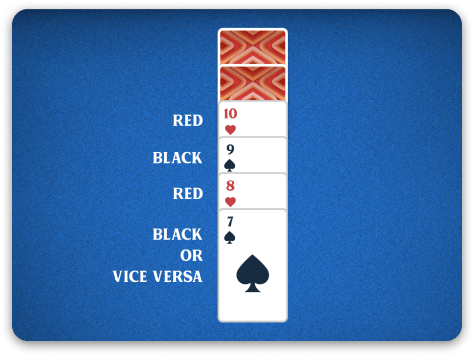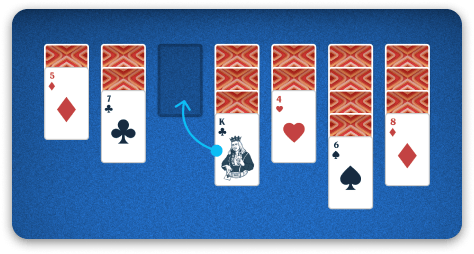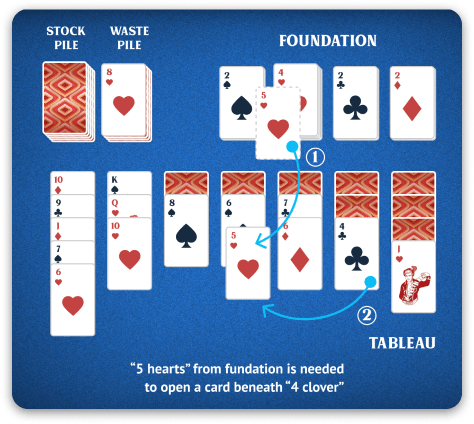The Optimal Strategy for winning Solitaire varies because of the differences between Draw 1 (Las Vegas Solitaire for real money) and Draw 3 (Klondike for fun) game rules. This page mainly discusses the different strategies for playing Vegas Solitaire.
This article can also help you play Solitaire (Draw 3) as it relates to the Basic Optimal Solitaire Strategy.

Introduction to the Optimal Strategy of Vegas Solitaire
To play Las Vegas Solitaire, it is best to understand the strategies below and be aware of the game rules for each Solitaire.
Klondike Solitaire offers the same Solitaire Set Up and rules as Las Vegas Solitaire. However nowadays, it is often played with the Draw 3 rule instead of Draw 1.
For Vegas Solitaire, the following signature rules apply:
- Draw 1 card at a time from the Stockpile
- You can only go through the deck once
The goal of Las Vegas Solitaire is to win more money from the bank than your initial bet. To reach this goal the object is to play 11 or more cards on the foundation piles.
The strategies described here are based on the Vegas Solitaire signature rules when playing Solitaire for real money
So now let’s go and read the ultimate strategy guide to win more often with Klondike Solitaire (Vegas Mode)
TIP! Always start the game with “Peeking”
Before you look at the Tableau, your first move is to turn the first card of the Stockpile. You now have more information about the first card to play if you get stuck on the Tableau.
Optimal Strategy of Vegas Solitaire
The Optimal Vegas Solitaire Strategy is also applicable to standard Klondike Solitaire. Whatever version of Klondike you play, Las Vegas Solitaire included, the following strategic moves comprise the Basic Optimal Strategy:
Best way of playing cards to the Foundation
If possible, immediately play an Ace and its same suit Deuce to the Foundation.
Avoid building up one particular suit much higher than the others. When you build ahead, you will run into problematic situations later. If you aim to finish the game but are building too far ahead, you will most likely not succeed.
Exception!
Ignore the rule above if you are able to play ahead and pile up enough cards to reach a minimum of 11 cards to earn a profit. Just know the chance to finish the game completely is drastically reduced.
Best way of playing the Tableau cards
To have a chance of winning, the priority in the game is to “expose” the cards lying face down in the Tableau columns. The face-up card you see in each column is available to play.
Basic playing strategies below are recommended when playing Tableau cards:
- Always play a face-up card, or a sequence row of cards, if that “exposes” a new card.
- If you have a King to play, prioritize moving a card, or row of cards to another row, so you can create a space, an empty column, for the King to fill in.
- If you don’t have a King waiting, don’t move the final card in a row to another row. Ex: a red 8 is the last card in a row. You could move it to the black 9. But what if you draw the other red eight next? The black Nine is now covered up by that red eight from the Tableau, and cannot play the new red eight.
- There are situations where you can choose between two columns having a card you can play. Choose the most extended column, the row with the most cards left to be exposed. Generally, this is the row on the far right with six cards face down from the start.
Exception! If you have a King to play, choose to create a space for it by playing the column with just one / final card in the row. - Try to avoid creating gaps if you don’t have any Kings. Keeps your options open, as illustrated in #3 above.
- If there is a choice between playing a card from the Tableau or the Waste Pile, play it from the Tableau first, unless it is a low card. You want to keep low cards available for play on the Foundation.
- There is one exception to moving the final card to another row when you do not have a King present to fill the space. See “Family Tree Strategy” below for an explanation of this unique strategy.
Advanced Solitaire Play – Strategies for Champions
It’s important to understand the Basics of Vegas Solitaire Strategy and the Solitaire Game rules. Below, although not always possible to apply, implementing one or more of these strategies is to your advantage.
Obviously, it depends on which cards you are dealt and when certain cards become available. When and where applicable, these playing styles will help you to finish the game more often.
1. Family Tree Solitaire Strategy

The Family Tree Strategy applies to how you build the cards on the Tableau. According to the rules, you can only place the cards under each other when they are descending in order and different in color.
The Family Tree Strategy aims to have the rows you build consist of one particular Red and one particular Black suit.
Example
This will not always be possible, of course. But if you have the possibility, always try to arrange your columns to build up a family of two specific, alternate suits.
The advantage of this strategy is that it will help you in the endgame to be able to play more cards to the Foundations.
Another name people use for this particular strategy is playing “Smooth” or “Smooth Play.”
2. Low Card Protection
The Low Card Protection is an advanced type of Solitaire play where you focus on building up the Foundations in an even way, thus preventing problems with low cards in the future.
During a game, you may be able to build up one Foundation pile up to a high number, yet, you are not even starting to build the Foundation of another suit.
It may sound tempting to build up, especially if you play the Vegas Score, where you get paid for every card in return. But, unless you can build up to 11 cards right away (and make a small profit), building up this way will decrease your chance of winning in the long term.
Therefore, always try to play according to the Low Card Protection Strategy. This Solitaire Strategy is divided into two sections:
- Deuce Protection
- Lowest Card Protection
Deuce Protection
The Deuce protection strategy is critical when playing Vegas Solitaire. Since you can only go through the deck once, it’s crucial to prevent low cards from getting buried under the waste pile. You need always to have a spot available to play the Deuce just in case one shows up from the deck.
Don’t build threes onto the Foundation ahead of time because this might prevent a future opportunity for you to play a deuce to the Tableau.
Lowest Card Protection
The Lowest Card Protection is a strategy where you only play a card to the Foundation under the condition that you have a space available for the lowest “covered” card to be placed on the Tableau.
A covered card means that the card didn’t show up yet. It’s not exposed yet. The Lowest Card Protection strategy will help you play all cards equivalent to the Foundations and improve your chances of winning.
Example:
- All Foundation piles are filled up with the Aces and Deuces.
- One suit, let’s say, Diamond, is built up to Three.
Now you can play a Diamond 4 card to the Foundation.
What do you do?
The correct play regarding the Lowest Card Protection Strategy is placing the Diamond 4 on the Tableau in anticipation of one or both black three cards appearing. However, if you already have a 4 of Hearts on the Tableau, you have ‘kept space’ for a black three to be placed onto the Tableau once it appears.
The Lowest Card Protection strategy always focuses on saving enough options to play the lowest cards in the game. It’s essential to keep track of this closely since you need the lowest cards to build up as many cards as possible to the Foundation.
3. Advanced King Plays
You can immediately play a King to fill an empty space and start a new column. However an advanced King play might be a better move.

Don’t always play a King immediately to an empty spot. When you have a King available to move into the empty area, but it doesn’t open a new card, then first ask yourself the following questions before you place the King:
Do I have a Queen, alternating color with the King, blocking a column?
- If the answer is yes, you can fill the empty gap with an alternating King and immediately play the Queen to free a new card in that column.
Do I have a Queen, the same color as the King, blocking a column?
- If you have a Queen of the same color as an available King, it might be a good idea NOT to play the King, opting to wait and expose a King of an alternate color. Then you can move the Queen into position under that King.
The reason for this play is to anticipate to the cards already open on your Tableau:
- If you have to choose what color King to use to fill an empty gap, and there are no Queens, you might choose based on the available Jack(s). If you have a black Jack, you select the Black King, so you can immediately play the Black Jack when you catch a red Queen.
4. “Worrying Back”
Worrying Back is the original term for bringing cards already played to the Foundations into the game. The advantage of using the advanced play of “Worrying Back” is to unblock the game and make space to play low cards that have yet to appear but may.

Please be aware that when you play Vegas Solitaire and “Worry Back,” earned credits will be deducted for every card you take back from the Foundations.
In normal Klondike, where you play without money, it is advisable always to use this play because it’s the only way to complete the game. However, when you play Vegas Solitaire, it might not always be the most profitable move in the end.
5. “Cashing In”
The more advanced and experienced solitaire player will recognize quickly enough if the game is winnable or not. In some games of Vegas Solitaire, you can’t prevent your low cards from getting buried in the waste pile. Since you can only go through the deck once, advanced players will recognize their chances to outplay the game.
As soon as you recognise this, it is essential to stop with the previously described strategies. The only goal is to play as many cards to the Foundations as possible to secure your winnings.
Vegas Solitaire Betting Strategies
Since Vegas Solitaire online is a casino gambling game, it’s important to look at the possibilities of using betting strategies to increase your chances. A famous betting strategy used in roulette is the Martingale betting system. Here, the player doubles the stakes as soon as he loses his bet. When you have infinite wealth and the betting limits allow it, you can keep doubling your last bet until you win.
For these reasons, casino games have limits, rendering it impossible to keep doubling your stake. However, you can still use this strategy to gather more points, even with Las Vegas Solitaire.
When you lose two matches, try to give it a shot on a higher stake. If you win, you might immediately win back all your previous losses. The flipside of this is that it can also end up disastrous; you only double your losses at a faster pace.